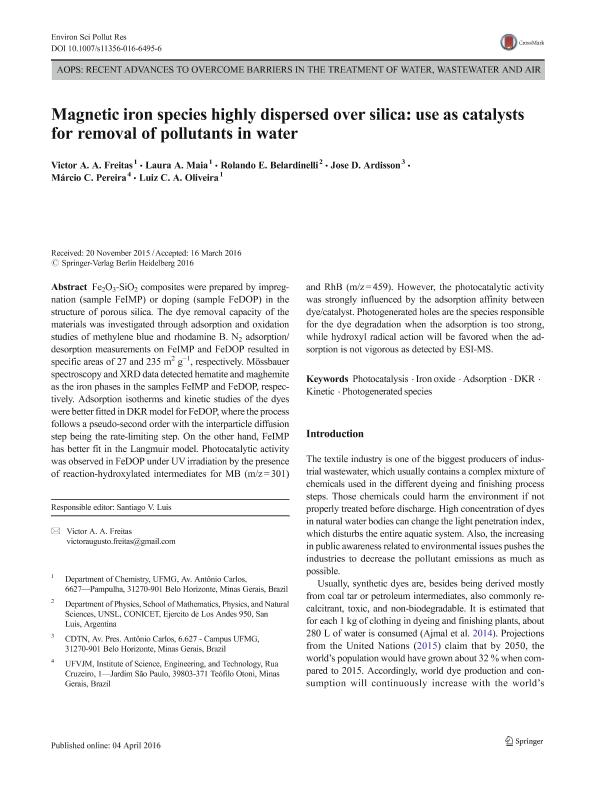Artículo
Magnetic iron species highly dispersed over silica: use as catalysts for removal of pollutants in water
Freitas, Victor A. A.; Maia, Laura A.; Belardinelli, Rolando Elio ; Ardisson, Jose D.; Pereira, Márcio C.; Oliveira, Luiz C. A.
; Ardisson, Jose D.; Pereira, Márcio C.; Oliveira, Luiz C. A.
 ; Ardisson, Jose D.; Pereira, Márcio C.; Oliveira, Luiz C. A.
; Ardisson, Jose D.; Pereira, Márcio C.; Oliveira, Luiz C. A.
Fecha de publicación:
03/2017
Editorial:
Springer Heidelberg
Revista:
Environmental Science and Pollution Research
ISSN:
0944-1344
e-ISSN:
1614-7499
Idioma:
Inglés
Tipo de recurso:
Artículo publicado
Clasificación temática:
Resumen
Fe2O3-SiO2 composites were prepared by impregnation (sample FeIMP) or doping (sample FeDOP) in the structure of porous silica. The dye removal capacity of the materials was investigated through adsorption and oxidation studies of methylene blue and rhodamine B. N2 adsorption/desorption measurements on FeIMP and FeDOP resulted in specific areas of 27 and 235 m2 g−1, respectively. Mössbauer spectroscopy and XRD data detected hematite and maghemite as the iron phases in the samples FeIMP and FeDOP, respectively. Adsorption isotherms and kinetic studies of the dyes were better fitted in DKR model for FeDOP, where the process follows a pseudo-second order with the interparticle diffusion step being the rate-limiting step. On the other hand, FeIMP has better fit in the Langmuir model. Photocatalytic activity was observed in FeDOP under UV irradiation by the presence of reaction-hydroxylated intermediates for MB (m/z = 301) and RhB (m/z = 459). However, the photocatalytic activity was strongly influenced by the adsorption affinity between dye/catalyst. Photogenerated holes are the species responsible for the dye degradation when the adsorption is too strong, while hydroxyl radical action will be favored when the adsorption is not vigorous as detected by ESI-MS.
Palabras clave:
Adsorption
,
Dkr
,
Iron Oxide
,
Kinetic
,
Photocatalysis
,
Photogenerated Species
Archivos asociados
Licencia
Identificadores
Colecciones
Articulos(INFAP)
Articulos de INST. DE FISICA APLICADA "DR. JORGE ANDRES ZGRABLICH"
Articulos de INST. DE FISICA APLICADA "DR. JORGE ANDRES ZGRABLICH"
Citación
Freitas, Victor A. A.; Maia, Laura A.; Belardinelli, Rolando Elio; Ardisson, Jose D.; Pereira, Márcio C.; et al.; Magnetic iron species highly dispersed over silica: use as catalysts for removal of pollutants in water; Springer Heidelberg; Environmental Science and Pollution Research; 24; 7; 3-2017; 6114-6125
Compartir
Altmétricas



